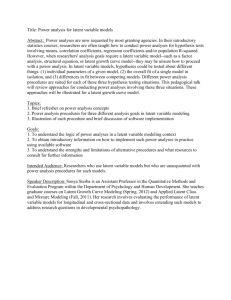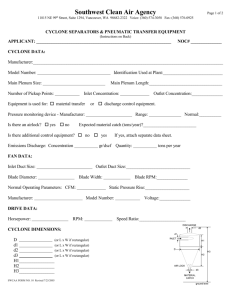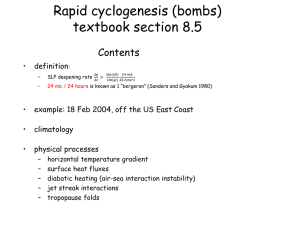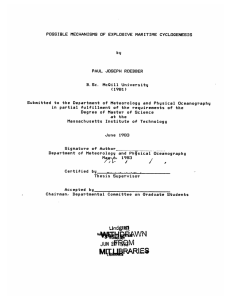reference_summaries
advertisement
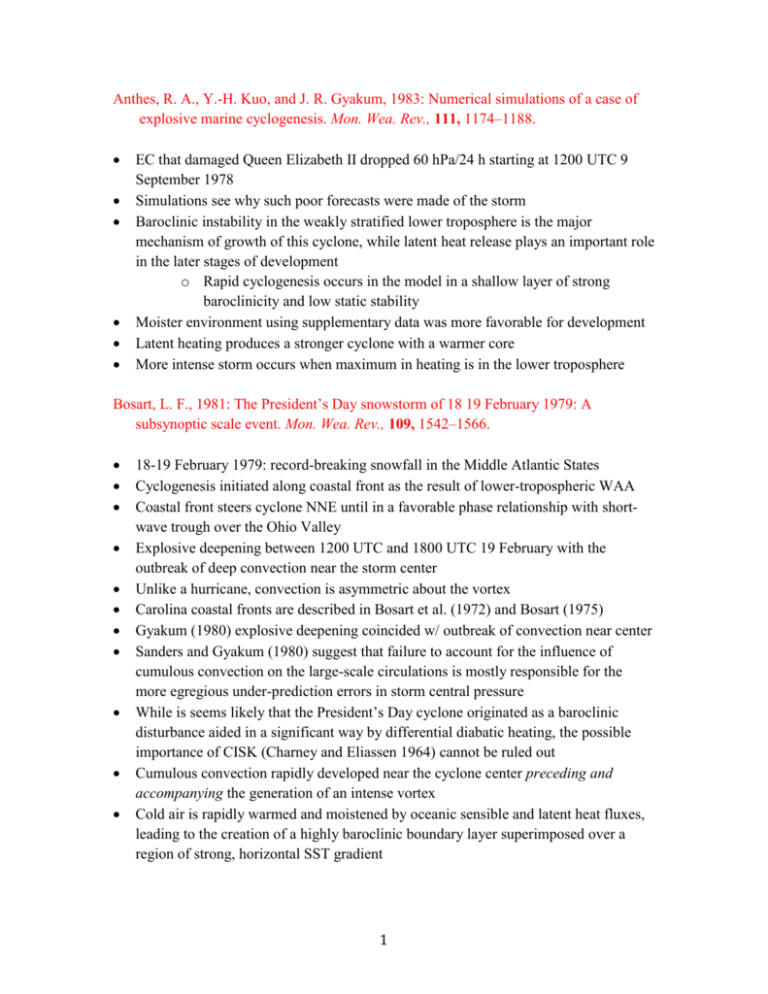
Anthes, R. A., Y.-H. Kuo, and J. R. Gyakum, 1983: Numerical simulations of a case of explosive marine cyclogenesis. Mon. Wea. Rev., 111, 1174–1188. EC that damaged Queen Elizabeth II dropped 60 hPa/24 h starting at 1200 UTC 9 September 1978 Simulations see why such poor forecasts were made of the storm Baroclinic instability in the weakly stratified lower troposphere is the major mechanism of growth of this cyclone, while latent heat release plays an important role in the later stages of development o Rapid cyclogenesis occurs in the model in a shallow layer of strong baroclinicity and low static stability Moister environment using supplementary data was more favorable for development Latent heating produces a stronger cyclone with a warmer core More intense storm occurs when maximum in heating is in the lower troposphere Bosart, L. F., 1981: The President’s Day snowstorm of 18 19 February 1979: A subsynoptic scale event. Mon. Wea. Rev., 109, 1542–1566. 18-19 February 1979: record-breaking snowfall in the Middle Atlantic States Cyclogenesis initiated along coastal front as the result of lower-tropospheric WAA Coastal front steers cyclone NNE until in a favorable phase relationship with shortwave trough over the Ohio Valley Explosive deepening between 1200 UTC and 1800 UTC 19 February with the outbreak of deep convection near the storm center Unlike a hurricane, convection is asymmetric about the vortex Carolina coastal fronts are described in Bosart et al. (1972) and Bosart (1975) Gyakum (1980) explosive deepening coincided w/ outbreak of convection near center Sanders and Gyakum (1980) suggest that failure to account for the influence of cumulous convection on the large-scale circulations is mostly responsible for the more egregious under-prediction errors in storm central pressure While is seems likely that the President’s Day cyclone originated as a baroclinic disturbance aided in a significant way by differential diabatic heating, the possible importance of CISK (Charney and Eliassen 1964) cannot be ruled out Cumulous convection rapidly developed near the cyclone center preceding and accompanying the generation of an intense vortex Cold air is rapidly warmed and moistened by oceanic sensible and latent heat fluxes, leading to the creation of a highly baroclinic boundary layer superimposed over a region of strong, horizontal SST gradient 1 Bosart, L. F., and S.C. Lin, 1984: A diagnostic analysis of the Presidents’ Day storm of February 1979. Mon. Wea. Rev., 112, 2148–2177. 18-19 February 1979: record-breaking snowfall in the Middle Atlantic States Initial growth of lower-tropospheric cyclonic vorticity is associated with convergence along the Carolina coastal front Coastal frontogenesis responds to differential warming and moistening in in conjunction with sensible heating over the ocean and the blocking of shallow cold air by the southern Appalachian Mountains Impact of convection is not discussed in this paper Jet streak locations contributed to frontogenesis along the Carolina coast Comparison of the kinematic, quasi-geostrophic, and semigeostrophic vertical motions is presented Kinematic method best captured vertical motions pre-cyclogenesis, flow highly ageostrophic at that time… all come into better agreement later with semigeostrophic being the closest to observations Moisture flux convergence intensifies as coastal frontogenesis commences Barotropic processes were more important in generating kinetic energy in the storm environment, whereas baroclinic processes dominate the immediate storm area Vertical advection of vorticity was also important from the lower troposphere up Grams, C. M., and Coauthors, 2011: The key role of diabatic processes in modifying the upper-tropospheric wave guide: A North Atlantic case study. Quart. J. Roy. Meteor. Soc., 137, 2174–2193. Case study of wave amplification in the North Atlantic/European sector (Sept 2008) Cross isentropic transport of low-PV air within WCB (low PV produced diab.) Sources: 1) Diabatic heating impact on development of ECs 2) Diabatic redistribution of PV in the vertical 3) Rossby wave train (RWT) Use equivalent potential temperature (theta-e) over potential temperature (theta) to show fronts Gyakum, J. G., 1983a: On the evolution of the QE II storm. I: Synoptic aspects. Mon. Wea. Rev., 111, 1137–1155. Hurricane-force winds battered the liner Queen Elizabeth II on 10-11 September 1978 Originated as shallow baroclinic disturbance west of Atlantic City, NJ 60 hPa/24 h Suggested that deep convection, like in TC formation, played a substantial role 2 Surface low was “steered” by warm advection to the left of the upper-level flow, in contrast to most surface lows Deep convection associated with MCC responsible for rapid deepening Development of upper-level trough after the surface low appeared, similar to President’s Day snowstorm (Bosart 1981) Gyakum, J. G., 1983b: On the evolution of the QE II storm. II: Dynamic and thermodynamic structure. Mon. Wea. Rev., 111, 1156–1173. Assesses the importance of heating on cyclogenesis (use PV to assess) PV generation was concurrent with explosive deepening Relatively weak baroclinic forcing helped to organize convective bulk heating Studied deep convection because of the hurricane-like wind and cloud field (CISK) “Tracton (1973) has presented evidence for convective processes triggering cyclogenesis in a series of continental cases.” “Bosart (1981) has shown the President’s Day (February 1979) cyclone’s rapid intensification to have been associated with deep convection near its clear, eyelike center.” Temperature rise in center of cyclone due to bulk heating effects Reed, R. J., 1979: Cyclogenesis in polar air streams. Mon. Wea. Rev., 107, 38–52. Cyclones forming in polar air masses Forming on the poleward side of the jet stream CISK and diabatic heating deemed important when on the poleward side of primary midlatitude temperature gradient Reed, R. J., A. J. Simmons, M. D. Albright, and P. Undén, 1988: The role of latent heat release in explosive cyclogenesis: Three examples based on ECMWF operational forecasts. Wea. Forecasting, 3, 217–229. Study looks at two well-predicted North Atlantic cyclones Danard (1964) carried out a diagnostic study that convincingly demonstrated the importance of latent heat release in a single case Hoskins (1980) dry forecast of a western North Pacific EC showed the importance of latent heat release to EC deepening “The percentage [of deepening that LHR accounts for] can vary from case to case and with geographical region and season.” 3 “Thus, we seek numbers that can be used with others to provide statistical and climatological conclusions.” Latent heat release was found to account for 40% to 50% of deepening Only ¼ of the latent heating effect was attributed to convective heating?? Impact of latent heat release was largest near the storm centers Sanders, F., and J. R. Gyakum, 1980: Synoptic-dynamic climatology of the “bomb.” Mon. Wea. Rev., 108, 1589–1606. “Bombs” are a primarily maritime, cold-season, event with hurricane-like features Typically found ~400 n mi downstream of a 500 hPa mobile trough Explosive development occurs over a wide range of SSTs, but, preferentially, near the strongest gradients 1979 Fastnet yacht race = summer example of a bomb (Rice 1979) “Some physical effect other than the commonly understood large-scale baroclinic mechanism may play an important role” Explosive deepening is a characteristic of the vast majority of the deepest cyclones Bergeron is adjusted for latitude (24 hPa/24 h at 45N) Occur within or poleward of the main belt of westerlies Development occurs in a region of upper-level diffluence Schemm, S., H. Wernli, and L. Papritz, 2013: Warm conveyor belts in idealized moist baroclinic wave simulations. J. Atmos. Sci., 70, 627–652. Idealized modeling study WCB = cross-isentropic flow propelled by release of latent heat due to condensation of water vapor in the lower troposphere and ice phase processes in the upper-trop. “PV thinking” useful because of conservation property of PV for adiabatic and frictionless flows and for invertiblity principle, which allows diagnosis of the balanced flow field from the PV of the atmosphere and suitable boundary conditions In the presence of diabatic effects, entropy is not conserved and PV loses its material conservation property. These diabatic effects comprise a wide range of physical phenomena, among which are radiation, surface fluxes, and phase transitions of water in clouds. Primary cyclone intensifies faster in moist simulation, mainly due to enhanced baroclinic conversion (EKE budget) Moist cyclone develops a more intense bent-back warm front where the largest latent heating occurs Direction of warm conveyor belt can vary (rWCB and fWCB) 4 Schemm S, and H. Wernli, 2014. The linkage between the warm and the cold conveyor belts in an idealized extratropical cyclone. J. Atmos. Sci., 71, 1443–1459. Formation of a cold conveyor belt (CCB), linkage to WCB, and their impact on the development of a midlatitude cyclone CCB: Weak ascent, strong increase in PV, close to surface on cold side of bent-back warm front, PV increases below latent heat release (LHR) o Important impact: enhanced the low-level jet along the tail of the bentback warm front WCB: Maximum ascent, negative PV anomaly in the upper-troposphere o Important impact: enhancement of downstream cyclogenesis due to the perturbation of the downstream Rossby waveguide 60% of all winter cyclones in the northern hemisphere have a WCB Tracton, M. S., 1973: The role of cumulus convection in the development of extratropical cyclones. Mon. Wea. Rev., 105, 469–476. “Significant convection occurs in the center of storms generally only during the early stages of their life history” Convective activity away from the center appears to not be crucial In the midlatitudes, the fundamental mechanism of cyclogenesis is the baroclinic instability of the meandering westerlies (Charney 1947, Eady 1949). ECs thus have as their basic source of energy the large-scale temperature contrast between air masses Aubert (1957) found that released latent heat tended to lower the heights of isobaric surfaces in the lower troposphere and raise them in the upper troposphere. These changes resulted in a deepening of the low-level cyclone and acceleration of the rate of movement. Danard (1964, 1966) demonstrated that the release of latent heat could contribute significantly to the production of the storm’s available potential energy and to an increased rate of generation of kinetic energy. Storms considered in this study formed over the eastern two-thirds of the United States or western Atlantic Close proximity to warm moist air (Gulf of Mexico/Caribbean Sea) it is an area particularly susceptible to the generation of the convective instability necessary for the occurrence of shower activity (Fawbush et al. 1951) 5


